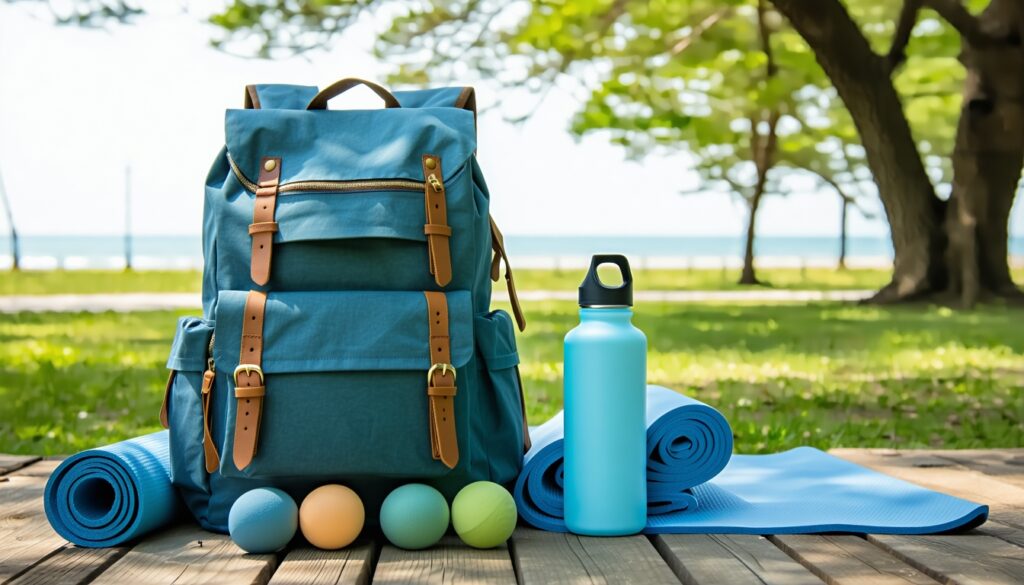Essential Features to Seek in a Yoga Backpack || Beginner’s Guide

Choosing the Perfect Yoga Backpack
Selecting the right yoga backpack is essential for health-conscious individuals who regularly practice yoga. A well-chosen backpack not only makes it easier to transport yoga gear but also enhances the overall experience. Here are some key factors to consider and material selections to keep in mind.
Factors to Consider
When deciding on a yoga backpack, several factors should be taken into account to ensure it meets individual needs:
| Factor | Description |
|---|---|
| Size and Capacity | The backpack should be spacious enough to hold a yoga mat, water bottle, and other essentials without being overly bulky. |
| Durability and Material | Look for high-quality materials that can withstand daily use and environmental conditions. |
| Comfort and Fit | Adjustable straps are important for a customized fit, ensuring comfort while distributing weight evenly across the shoulders and back. |
| Convenience Features | Extra compartments for organizing belongings, such as water bottles, phones, and keys, can enhance usability. |
| Style and Design | Choose a design that reflects personal style while being functional. |
Material Selection
The material of a yoga backpack plays a significant role in its performance and longevity. Here are some common materials and their benefits:
| Material | Benefits |
|---|---|
| Nylon | Lightweight, durable, and often water-resistant, making it ideal for various weather conditions. |
| Canvas | Sturdy and stylish, canvas backpacks are often eco-friendly and can withstand wear and tear. |
| Neoprene | Offers flexibility and water resistance, making it suitable for those who practice in different environments. |
| Water-Resistant Fabrics | Essential for keeping the yoga mat and other belongings dry, especially in wet conditions. |
A yoga mat backpack with a dedicated yoga mat holder is also beneficial, as it keeps the mat clean and secure while on the move.
By considering these factors and material options, individuals can find a yoga backpack that is both practical and stylish, enhancing their yoga practice and lifestyle. For more insights on choosing the right backpack, check out our guide on how to choose the right yoga backpack for your practice.
Essential Yoga Gear for Beginners
For those embarking on their yoga journey, having the right gear is essential for a comfortable and effective practice. Here are the key items every beginner should consider.
Yoga Mat
A high-quality yoga mat is fundamental for a safe and comfortable practice. It provides non-slip, cushioned support, which is crucial for stability during poses. Premium mats made from quality materials are recommended as they offer better traction and cushioning, reducing the need for frequent replacements (Yoga Beyond The Studio).
| Feature | Description |
|---|---|
| Thickness | 4-6 mm is ideal for cushioning |
| Material | PVC, TPE, or natural rubber for eco-friendliness |
| Texture | Non-slip surface for stability |
Yoga Clothing
Comfortable and flexible clothing is vital for practicing yoga. Beginners should look for breathable fabrics that allow for a full range of motion. Clothing should fit well but not be too tight, allowing for easy movement during various poses.
| Clothing Item | Recommended Features |
|---|---|
| Tops | Moisture-wicking, fitted or loose options |
| Bottoms | Stretchy leggings or shorts that allow movement |
| Layers | Lightweight jackets for warmth before and after class |
Yoga Props
Yoga props can enhance the practice by providing support and improving alignment. Essential props for beginners include:
- Yoga Blocks: Help improve flexibility and alignment, offering extra support in certain poses.
- Yoga Bolsters: Provide support for relaxation and restorative poses.
- Yoga Straps: Assist in stretching and achieving difficult poses.
- Yoga Blankets: Offer comfort and support during seated poses or meditation.
- Myofascial Release Props: Help relieve muscle tension.
- Meditation Cushions: Enhance comfort during meditation sessions.
Having these essential items will help beginners establish a solid foundation for their yoga practice. For more information on what to look for in a yoga backpack, check out our guide on how to choose the right yoga backpack for your practice.
Features of a Functional Yoga Backpack
When searching for the ideal yoga backpack, it is essential to consider several features that enhance functionality and convenience. This section highlights the key aspects to look for in a yoga backpack.
Size and Capacity
The size and capacity of a yoga backpack are crucial for accommodating all necessary gear. A well-sized backpack should have enough space for a yoga mat, clothing, and any additional accessories. Here’s a quick overview of common sizes and their typical capacities:
| Backpack Size | Capacity (Liters) | Ideal For |
|---|---|---|
| Small | 15-20 | Minimalist users, light gear |
| Medium | 20-30 | Regular yoga practitioners |
| Large | 30+ | Those carrying extra props or travel gear |
A backpack with a dedicated yoga mat holder is particularly beneficial, as it keeps the mat secure and separate from other items, ensuring cleanliness and easy access.
Durability and Comfort
Durability is a key factor when selecting a yoga backpack. Look for materials that can withstand daily use and environmental conditions. Water-resistant materials are particularly useful, as they help keep the yoga mat and other belongings dry during wet weather.
Comfort is equally important. Adjustable straps allow for a customized fit, distributing weight evenly across the shoulders and back. This feature is essential for preventing discomfort during transport.
Convenience Features
Convenience features can significantly enhance the usability of a yoga backpack. Extra compartments are beneficial for organizing belongings, providing separate spaces for items like water bottles, phones, keys, and yoga accessories.
Other useful features include:
- Dedicated yoga mat holder: Keeps the mat secure and clean.
- Padded straps: Increases comfort during transport.
- External pockets: Provides easy access to frequently used items.
By considering these features, individuals can find a yoga backpack that meets their needs and enhances their yoga practice. For more insights on selecting the right backpack, check out our guide on how to choose the right yoga backpack for your practice.
Types of Yoga Mat Bags
When selecting a yoga mat bag, it’s essential to consider the different styles available. Each type offers unique benefits that cater to various needs and preferences. Here are the three main types of yoga mat bags:
Sling Bags
Sling bags are designed for those who prefer a minimalist approach. They typically feature a single strap that allows the bag to be worn across the body, providing easy access to the contents. This style is ideal for quick trips to the studio or outdoor yoga sessions. Sling bags are compact and lightweight, making them a great choice for individuals who want to carry only the essentials.
| Feature | Description |
|---|---|
| Capacity | Usually holds a yoga mat and a few small items |
| Comfort | Lightweight and easy to carry |
| Accessibility | Quick access to items while on the go |
For more information on the pros and cons of different bag styles, check out our article on yoga mat backpack vs tote vs strap: pros and cons.
Backpack-Style Bags
Backpack-style bags are perfect for those who need to carry more gear. They offer balanced weight distribution, making them comfortable for longer commutes or travel. These bags often come with multiple compartments, allowing for organized storage of yoga mats, clothing, props, and personal items. Backpack-style bags are versatile and suitable for everyday use, whether heading to a yoga class or running errands.
| Feature | Description |
|---|---|
| Capacity | Can hold a yoga mat, props, and personal items |
| Comfort | Even weight distribution for comfortable carrying |
| Organization | Multiple pockets for easy access to items |
For recommendations on the best lightweight options, visit our article on best lightweight yoga backpacks for commuting.
Tote Bags
Tote bags are a stylish and functional option for carrying yoga gear. They typically have a spacious interior, making them suitable for those who prefer to carry a variety of items. Tote bags can be used for yoga classes, trips to the gym, or even as everyday bags. While they may not offer the same level of support as sling or backpack-style bags, they are versatile and can be easily folded for storage.
| Feature | Description |
|---|---|
| Capacity | Spacious enough for a yoga mat and additional items |
| Style | Often more fashionable and can double as a daily bag |
| Accessibility | Easy to access items without removing the bag |
For tips on how to care for your yoga mat bag, check out our article on how to clean and maintain your yoga backpack.
Choosing the right type of yoga mat bag depends on individual preferences and needs. Whether opting for a sling bag, backpack-style bag, or tote bag, each option provides a practical and stylish way to carry yoga gear.
Selecting the Ideal Yoga Mat Bag
Choosing the right yoga mat bag is essential for health-conscious individuals who want to carry their gear conveniently and stylishly. This section will cover material options, size compatibility, and brand recommendations to help in selecting the ideal yoga mat bag.
Material Options
When selecting a yoga mat bag, the material plays a significant role in durability and functionality. Common materials include:
| Material | Benefits |
|---|---|
| Cotton | Soft, breathable, and eco-friendly |
| Canvas | Durable and sturdy, often water-resistant |
| Nylon | Lightweight, water-resistant, and easy to clean |
| Polyester | Strong, durable, and often more affordable |
| Eco-friendly | Made from recycled fabrics or organic cotton, promoting sustainability |
Each material offers unique benefits, such as durability and water-resistance, making it important to choose one that fits personal preferences and lifestyle needs.
Size Compatibility
Size compatibility is crucial when selecting a yoga mat bag. The bag should comfortably fit the yoga mat while allowing space for additional gear. Here are some common sizes:
| Yoga Mat Size | Recommended Bag Size |
|---|---|
| Standard (24″ x 68″) | Medium (up to 26″ wide) |
| Extra Long (24″ x 72″) | Large (up to 28″ wide) |
| Thick Mats (up to 1/2″) | Extra Large (28″ or more) |
It’s essential to ensure that the bag can accommodate not just the mat but also any additional items like towels, water bottles, or yoga props. For more insights on different types of bags, check out our article on yoga mat backpack vs tote vs strap: pros and cons.
Brand Recommendations
Choosing a reputable brand can make a significant difference in quality and functionality. Some top brands known for their yoga mat bags include:
| Brand | Notable Features |
|---|---|
| Manduka | High-quality materials and eco-friendly options |
| Lululemon | Stylish designs with functional features |
| Gaiam | Affordable options with good durability |
These brands are recognized for their commitment to quality and functionality, making them popular choices among yoga practitioners.
By considering material options, size compatibility, and brand reputation, individuals can find the perfect yoga mat bag that meets their needs and enhances their yoga practice. For tips on maintaining your yoga backpack, visit our article on how to clean and maintain your yoga backpack.
Care and Maintenance Tips
Taking care of a yoga backpack is essential for ensuring its longevity and functionality. Regular cleaning, proper storage, and timely repairs can make a significant difference in how long the backpack lasts. Here are some tips for maintaining a yoga backpack.
Cleaning and Storage
To keep a yoga backpack in great shape, regular cleaning is key. Most backpacks can be wiped down with a damp cloth to remove dirt and sweat. For deeper cleaning, check the manufacturer’s instructions, as some bags may be machine washable. Proper storage is also important; keep the backpack away from direct sunlight to prevent fading and material degradation.
| Cleaning Method | Frequency |
|---|---|
| Wipe down exterior | After each use |
| Deep clean (if machine washable) | Monthly |
| Check for wear and tear | Weekly |
For more detailed cleaning instructions, refer to our guide on how to clean and maintain your yoga backpack.
Repair and Longevity
Timely repairs can extend the life of a yoga backpack. If zippers break or seams start to fray, addressing these issues promptly can prevent further damage. Look for backpacks made from durable materials like high-density nylon or polyester, as these are known for their strength and longevity.
Additionally, consider water resistance as a crucial feature. This ensures that belongings stay dry even in unexpected weather conditions. Opt for materials like treated nylon or polyester that are specifically designed to repel water.
By following these care and maintenance tips, individuals can ensure that their yoga backpacks remain functional and stylish for years to come.


